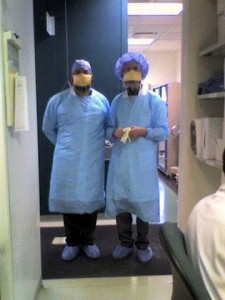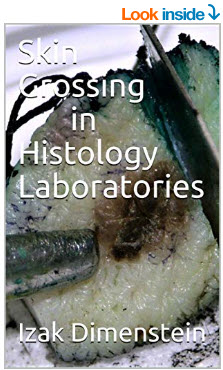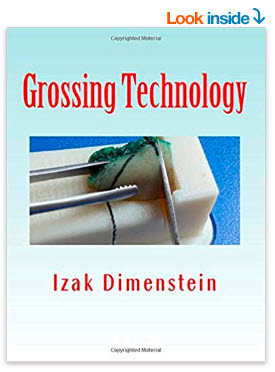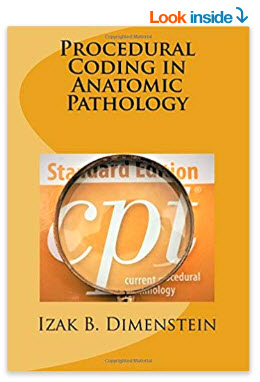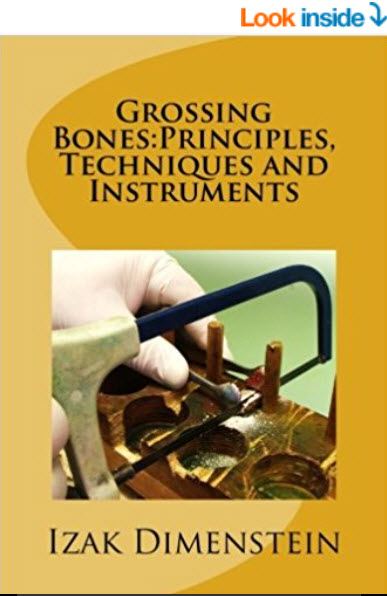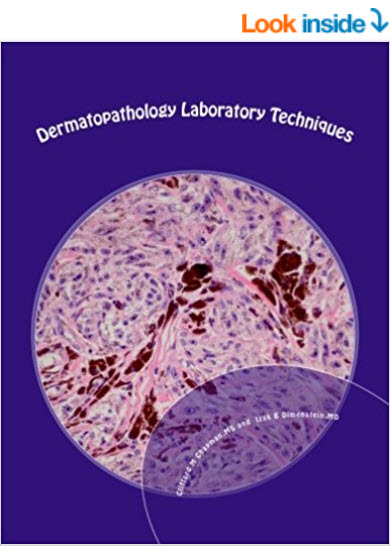These materials are an addition to the “Infection Exposure in Surgical Pathology Laboratory” article. The presented below pathology superficialities can be placed only on the website because a peer reviewed publication requires higher level of argumentation and references. But I’m reiterating that my webhome is my castle as the old British might have said if they had known the Internet.
OSHA‘s Bloodborne Pathogens Standard (29 CFR 1910.1030) safety requirements are more or less implemented in most surgical pathology laboratories. The cavalierly attitude towards infection exposure safety is gradually replaced by rational approaches. Safety measures cost money, efforts and inevitable inconvenience at the working place. All these measures, however, are done not only for an inspection display, although inspections are nervous institutions’ festivals when the management is able to enforce power and compliance, but the subordinates can demonstrate loyalty and submission. And everyone is happy when the commission had left without even noticing the masquerade.
In full gear. Ready for inspection.
On the serious note, there is no any credible data of acquired infection in surgical pathology laboratory. Any cohort epidemiological studies of laboratory-acquired infections in clinical settings are also absent. Even specialized research facilities have not published any materials about laboratory-acquired infection besides some sporadic cases. Of course, the preventive measures might contribute to this bright picture, but nobody in clear mind would try to prove otherwise. The Max von Pettenkofer’s experiment when he drunk a glass of water with cholera vibrions will not be repeated. Actually, he only proved that conditions of infection exposure should be taken into account. By the way, Pettenkoffer’s young associate was not fortunate in a similar experiment. What about the mass Petenkoffer like experiment when generations worked without or with minimal protection in pathology laboratories? Of course, there were different conditions of microbiological landscape and laboratory environment. However, the question remains lingering: Is not the harmful effect of infection exposure in surgical pathology laboratory a hoax?
There might be two aspects:
First, pure Pettenkofer’s stipulation as conditions of the body. Strong acid in stomach as positive condition for cholera tolerance.
Second, the immunological condition of the individual at the moment of exposure. Acquired immunodeficiency syndrome (AIDS) as an extreme negative condition. There is a stipulation that Pettenkofer had developed immunity from an earlier, mild infection.
In accidental inoculation, not every exposure results in a manifesting infection disease. A risk assessment for infection depends on many factors as the host’s immune system, mechanism of the exposure, environment conditions, infectious dose of the exposure, virulence of the agent, its form (aerosol, solution). Combination of these conditions and numerous unnamed and unknown yet make infection exposures uncertain for a result.
Here is a broader approach to the infection exposure in surgical pathology laboratory as chronic challenge of the individual immunological system. The problem is discussed from a general pathology point of view with inevitable simplifications and scientifically unsupported stipulations.
Presented below considerations do not assume a proven hypothesis keeping in mind the vast of knowledge in the immunology literature. This is only an attempt to provide a different look at the problem that might be partially accepted or completely objected by professionals in the field.
The concept of temporary immunodeficiency challenge
Every living organism permanently fends off the environment’s foreign materials as part of maintaining the survival homeostasis. Primitive organisms have relatively elementary devices to cope with intruders. An ameba digests through phagocytosis in a food vacuole.
Vertebrates, humans among them, have developed adaptive defense systems for immunity. Besides innate (non-specific) immunity, as anatomical (skin, mucous membranes), physiological (temperature, lysozyme, interferon, complement, endocytosis, and phagocytosis) and pathological (inflammation), the specific immune system is the ultimate line of defense. This is an exquisitely dynamic network for precise targeting and elimination of the object after tolerance check.
Although the variety of foreign invaders is limitless, the main aim of the immune system is the protection from pathogenic microorganisms and cancer. Contemporary medicine provided a new challenge as transplants.
During the lifetime the emphasis on microorganisms diminishes due to developed acquired tolerance (humoral or cellular). With age, fight with cancer becomes more actual due to increase of cellular reproduction mistakes which require elimination of the turnouts as strangers (“transplants”) which do not meet tolerance threshold. Of course, it is a simplification because the fight with cancerous cells starts and continues during life time with numerous failures when aggressive tumors develop in childhood. Immunologic tolerance does not simply reflect the absence of an immune response, but rather an active response of the immune system that exhibits antigenic specificity and memory.
Humans are in a permanent race with our usual microorganism’s surrounding which has an advantage of high speed mutations. Prions also are an uncertain threat. This fight lasts for thousands years shaping the human population. Some microorganism disappear or become less relevant (Mycobacterium leprae), new microorganisms come or will come in play.
A simplistic kitchen/warehouse approach to temporary immunodeficiency
The mechanism of work of the immune system is enormously complicated. The literature includes libraries of books and articles. These remarks do not even try to jump in the sea of literature references.
Immunological system is part of a self organizing structure of a living organism. A well managed corporation resembles this unique efficient system developed during millions years of evolution. It is complicated in details but elementary in basics. Reciprocity is the main organizing principle.
As a fighting structure, immunological system works on a principle of ammunition demand and supply for immediate and postponed reaction. Demand is specific, but supply is overlapping and excessive with temporary deficiencies. The well known from general biology stress response can be an analogy.
There could be many mechanisms and systems involved in parallel or in reciprocal fashion. Among them, complement system is closer and understandable to my immunological education although I am definitely unaware how the tiny mechanisms of different complement systems work.
In my scientific youth, I performed the Bordet-Gengou complement fixation reaction (CFR) while preparing my PhD dissertation “Materials to Cytotoxic Models of Acute and Chronic Pancreatitis.” Experimental models of pancreatitis were developed by injection of specific antiorgan serums, which were called citotoxins.1 The warm variant of complement fixation reaction (CFR) measured the antibodies titer of the antiserum. I do not want to go into the details of that science more than 40 years ago. The approaches and methods are now completely different. The CFR in the warm variant was regarded even at that time as a gold standard though old fashioned. However, I could definitely see how the complement is consumed by an antigen-antibody reaction.
Complement is a group of serum proteins that circulate in an inactive proenzyme state. The proteins can be activated by a variety of specific and nonspecific immunologic mechanisms that convert the inactive proenzymes into active enzymes. The activated complement components participate in a controlled enzymatic cascade that results in membrane-damaging reactions, which destroy pathogenic organisms or facilitate their clearance. Complement system is only one, more or less unspecific component, of many immunological mechanisms. It is mentioned as an example of the complicated immunological system.
The infection exposure in surgical pathology laboratory becomes a safety issue when an additional demand in the immunological means is required besides more or less average supply for everyday median exposure to environment’s microorganisms and other foreign material. In prevention accidental infectious inoculation by dangerous pathogens, this overexposure can have consequences due to temporary immunodeficiency. Again, mentioning complement as an example, there is a definition of genetic complement deficiencies which can have clinical manifestations. In this regard, temporary insufficiencies can play a role in a case of a challenge to the immune system by additional to every day (“normal”) infection exposure in the laboratory.
Immunodeficiency disorders have many faces. Here are some of them.
- Congenital immunodeficiency is present at the time of birth as a result of genetic defects. These immunodeficiency disorders are also called primary immunodeficiency. Even though more than 70 different types of congenital immunodeficiency disorders have been identified, they occur rarely.
2. Acquired immunodeficiency is much more common than congenital immunodeficiency. The most known, unfortunately, is Acquired Immunodeficiency Syndrome (AIDS) caused by human immunodeficiency virus (HIV). However, this is not the most common cause of acquired immunodeficiency. Acquired immunodeficiency often occurs as a complication of other conditions and diseases. The most common causes of acquired immunodeficiency are malnutrition, some types of cancer, and infections.
Although temporary immunodeficiency exists as a definition, it is related to well circumscribed nosological entities including AIDS. However, a temporary condition of the immune system could determine the immunological reaction.
As a practical conclusion , it does not make any sense to add additional immunological challenges to the mechanisms of defense by infection exposure during professional work in surgical pathology laboratory.
Additional speculations
Although the Ehrlich-Tomas-Burnett immunological cancer surveillance theory was shaken by some recent experimental data, the basic idea remains of the immune response to malignant cells as an effective way of their elimination. The concept of cancer immune surveillance was redefined into “cancer immunoediting” with phases as elimination, equilibrium, and escape when the clinical tumor is developed. There are numerous mechanisms of immunological reaction to malignancy. They are different from immunological response to microorganisms. The effectivness of the immunological response depends on too many factors that it is impossible even to mention them in these remarks, but the bottom line is that additional exposure to infection in surgical pathology laboratory might contribute to the misbalance of natural immunological mechanisms of resistance to growth of malignant cells through their elimination. The older the person, the more significant might be this additional burden of infection exposure for immunological system as a whole to fight cancer or other related to immunological response diseases. As an extreme example, AIDS related cancers are not a rarity.
As a remote analogy, the fast digestible carbohydrates can play a certain role in the development of diabetes 2 in a case of intensive intake. If in a child without a genetic predisposition to diabetes such sugar consumption cannot be too harmful, though undesirable, in an older person, especially with a genetic predisposition, chronic challenge of insulin/glucagon systems could lead to diabetes 2 with other consequence.
Temporary hormonal insufficiency is well known. For example, temporary adrenal insufficiency can occur after stress or infection. A different example is temporary thyroid insufficiency.
There are some epidemiological studies about high standardized mortality ratios for lymphopoietic cancers among pathologists. These studies are relatively old (1973). They were attributed to damaging effect of formalin in old laboratories with limited ventilation and religious trust in the amount of fixatives (formalin/tissue ratio as 20:1). If the epidemiological observation were correct, I my view, the cause of higher incidents of cancer among the pathologists could be attributed to infection overexposure under conditions of minimal protective equipment.
More speculations
Perhaps, the formalin saturation in old laboratories was useful for disinfection at least against bacteria though not against viruses and prions. Although overexposure to formalin with damage of protective level of body (mucous layer, respiratory tract villia) could eliminate the anatomical line of immunity defense, a minimal, below the irritation threshold concentration of formaldehyde in the laboratory environment might be beneficial by having a positive effect on infection exposure. However, this could only diminish but not eliminate challenges to immune system, conditions that might cause temporary immunodeficiency.
Final speculations
The old, century- long dispute between causality (Virchow) and conditionality (von Hansemann, Verworn, Bergman) comes into play here. This was not a scholastic dispute, but we will not go too far in this direction. In my personal preferences and pathology education, I lean to conditionals. Temporary immunodeficiency is a condition that predisposes an individual to harmful consequences of acute and chronic infection exposure in surgical pathology laboratory. This might be a breach of defense lines against pathogenic microorganism as well as a background for malignancydevelopment.
Again, my apology for scientific superficiality of the concept.
- Dimenstein IB: The action of pancreotoxic serum on the exocrine apparatus of the pancreas in guinea pigs- Pathophysiology and Experimental Therapy, 1970; 5: 47-51.


